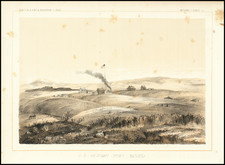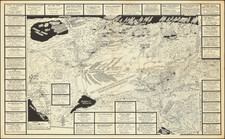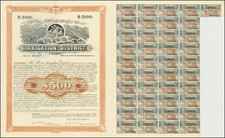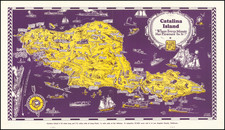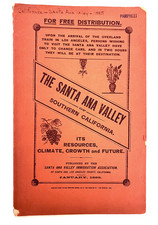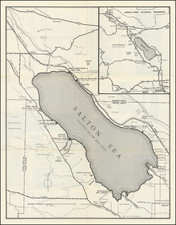One of the Most Desirable Suburban Towns in the World (Redlands Citrograph, October 29, 1887)
Previously unrecorded wall map of Mentone, California, published as a promotional item by the Pacific Land Improvement Company of Los Angeles, based upon the surveys of JPF Kuhlmann.
We suspect the present map was a unique or virtually unique example when it was printed, as we cannot locate any evidence that Pacific Land Improvement Company, an otherwise thriving promoter in the late 1880s in Southern California, took any meaningful steps to promote and sell land in Mentone. The map is now a unique survival, with no other examples known or recorded.
The image illustrates the town plan for the town of Mentone, which was developed by The Pacific Land Improvement Company at the very tail end of Southern California's land boom in the 1880s. Lying northeast of Redlands, it marks the practical end of the developable flat lands of the San Bernardino Valley (elevation about 1500 feet above sea level), before the valley ends and the mountains rise sharply into the San Bernardino Mountains, with peaks as high as nearly 12,000 feet over the next 15 linear miles to the east.
The graphic is quite exception, with the town plan at the center and ringed by promises of fertile valleys (supporting orange groves, grape vineyards, and pine trees for lumber), with a fine new train depot and proximity to the booming Inland Empire towns of San Bernardino, Colton and Riverside, whose role as a hub at the base of the Cajon Pass made the eastern end of the Inland Empire an attractive investment and natural final expansion point eastward from the Los Angeles Basin, before the Mountains and Deserts to the north and east made further development economically unviable the next century.
While the natural easternmost point in the north part of the Inland Empire and a natural point for a rail line to turn south toward the main line of the Southern Pacific Railroad as it passes through Yucaipa toward Arizona, Mentone never thrived and even today is merely a census place on the Eastern fringe of the San Bernardino Valley.
The map includes pencil annotations which include early landowner names, and the pencil lines may represent alternative routes for the railroad, as one can still see some diagonals extending across street lines from earlier, now abandoned rail lines.
It would appear that the Pacific Land Improvement Company never finalized its development of Mentone and transferred its interests or otherwise proceeded as a silent partner with other local developers, as W.P. McIntosh seems to have been the primary promoter in Mentone's early years.
Pacific Land Improvement Company (PLIC)
The Pacific Land Improvement Co. was incorporated on about January 5, 1887 (Los Angeles Times, January 6, 1887) in Los Angeles. Directors named were George H. Fullerton and Edward F. Kingman of Riverside, L.M. Fairbanks of Columbus, Ohio, F.S. Reigert of Topeka, Kansas and Williamson Dunn of Los Angeles. The purpose of the company was to buy and sell land, water and water rights, to improve land and construct ditches.
PLIC's first project was a 386 acre project (the town of Claremont), which was first referenced in the Los Angeles Times in February 1887. By May 23, 1887, PLIC had acquired land for the creation of two additional towns in Orange County, St. James (4 miles east of Anaheim), and Buena Park. By mid-June 1887, the company had platted "San Juan By The Sea" (Capistrano Beach) and by the end of August, it had launched the development of Fullerton, California and Santa Fe Springs.
Toward the end of September 1887, the company was moving eastward, launching the town of Lordsburg (renamed La Verne in 1906), but by that time, the land boom in Southern California had ended and no further development occurred and by 1890, the company was being sued for various reasons.
Mentone
The earliest mention of the proposed town of Mentone was on April 10, 1887, but with the promoter of W.P. McIntosh (Los Angeles Times). By August 14, 1887, a headline in the San Bernardino Daily Courier appears under the small headline of Real Estate Boom in Mentone. At that moment in time, the extension of the Southern California Railroad line was being considered to Redlands, Lugonia, Crafton and Mentone. An article in the Redlands Citrograph of October 29, 1887, discusses development of the town by a unnamed company. There is reference to a new tunnel and water source from the mountains, with plans for a fine hotel at a cost of over $100,000 nearing completion, with a contract for construction to be "let on Saturday," and contracts "have already been let" for the erection of ten or twelve cottages. . .[and] the Stan Fe Company intend to erect their hospital at this point . . . " The "Company" officers seem to have been H.L. Drake and N.K. Fairbanks ("nephew of General Smith of the Santa Fe System").
Articles of incorporation for the Mentone Irrigation Company were filed on November 14, 1887, with the directors being S.H. Martelle, A.G. Hubbard, W.P. McIntosh, M. Lambeth and Frank E. Stewart.
The San Bernardino Daily Courier noted in on December 20, 1887, that the railroad the terminus of the Southern California Rail Road was not Lugonia, but that the railroad had been graded all the way to Mentone. On March 13, 1888, the Courier announced the completion of the Valley railroad from Redlands to Mentone.
The first significant promotional advertisement for Mentone by the W.P. McIntosh Company seems to be on December 24, 1887, in the Redlands Citrograph.
The following is excerpted from an article in the Los Angeles Daily News, January 4, 2011:
After completion of the California Southern and the Southern Pacific railroads in the 1880s, a rate war broke out between the competing companies, kicking off one of the great land booms in history. . . . in San Bernardino County, opportunity-seeking land speculators found the perfect magnet for attracting frustrated Easterners fed up with the cold winters and humid summers back home. . . .
One opportunistic group was a corporation called the Mentone Co., formed in 1886 with W.H. Drew as president and N.K. Fairbanks as vice president. The company purchased 3,000 acres of land north of what was then known as Crafton and south of the Santa Ana River. By the following year, the town plat was surveyed and recorded under the supervision of W.P. McIntosh, one of the investors.
. . . “Mentone” was selected for the new town because of touted similarity to the resort of that name on the Italian-French frontier on the Mediterranean Sea. The climate and vegetation are about the same. But the similarity between the two “resorts” ends there. In order to lure naive Easterners, a bit of exaggeration was dished out. Doctored postcards were printed and mailed, one showing the beautiful Santa Ana River with boats sailing on it. Another featured green hills with what appeared to be sheep grazing but was really rocks from what is today proudly known as Mentone Beach.
McIntosh was a real estate agent in Los Angeles and he bought much of the land himself. He planted the first orange grove in Mentone in 1888 on Mentone Boulevard. Keeping acreage for himself on the corner of Crafton and Mentone Boulevard, he sold the rest of his land to people who wanted to build a home and settle in Mentone.
The Los Angeles Times raved about how San Bernardino County was evolving into the largest and most famous fruit-growing county in California on Sept. 5, 1891:
“At the extreme upper end of the San Bernardino valley is the foothill fruit colony of Mentone. It contains 2000 acres, which are practically above the frost and fog line. Over 200 acres were planted last spring, two-thirds of this acreage being oranges and one-third olives.” . . .
The Mentone Post Office opened on May 15, 1891, and one of the new town’s chief employers – The Mentone Sandstone Co. – was busy preparing stonework for the new San Bernardino County jail. The Times reported on March 14, 1892, that a man named G.S. Gray was in the process of erecting a $4,000 residence, while 10 acres of olive groves were being planted by a Mr. Miller and a large number of lots were purchased by Lorin Hall, who recently arrived from Oil City, Pa.
Best of all, a beautiful tourist hotel was built in Mentone at a cost of $30,000. Three stories high, with a basement and spacious veranda, the Hotel Mentone had its grand opening on April 9, 1892. The hotel – located on Opal Avenue south of Mentone Boulevard – was luxuriously furnished and surrounded by beautiful landscaping, a tennis court and what was said to be the finest croquet court in Southern California.
Despite being widely advertised by McIntosh, the hotel never did prosper. Due to financial issues and the simple fact that not enough tourists were arriving in Mentone as was initially hoped, Hotel Mentone was soon converted into a sanitarium for tubercular and asthmatic patients. The Los Angeles Times of Sept. 19, 1900, announced under the headlines “NEW HEALTH RESORT” and “Local and Other Physicians and Hotel Men to Build a Large Sanitarium Near Redlands”:
“The Mentone Sanitarium Association has secured a large tract at Mentone about two miles from Redlands to be the most complete and up to date institution of this kind in this part of the country.”
Unfortunately, this new vision for Mentone turned out to be another financial bust. The sanitarium changed hands several times and the beautiful structure finally was torn down in 1917. . .
Today’s Mentone is a quaint unincorporated community of around 10,000 people. And despite never having become a big-time tourist destination, for many of its residents who value the peace and quiet that comes with a rural lifestyle, their little “resort” is just fine the way it is.
Rarity
We were unable to locate any other examples of the map in OCLC or any other collections or reference books.









